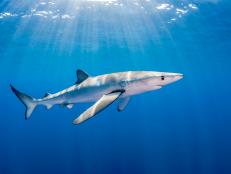All Nature Articles
Showing 91 - 105 of 320 results
Giraffes Have Daycares, Lunch Buddies, and Yearslong Relationships
Scientists discovered that giraffes are actually a highly complex social species, on par with elephants and chimpanzees.
NASA is Helping Save Sharks
As the battle to save species across the world wages on, conservation efforts are becoming more and more technological in tracking, monitoring and collecting data.And perhaps one of the most advanced techniques is currently being deployed by NASA, an unlikely ally in the fight to save sharks.
A Tribe in California is Desperately Battling to Save their Fish
The Yurok Tribe are known as the Salmon People. Fishing for salmon is in their blood, but now their way of life is a stake.
The ‘Immortal’ Plant Tells Its Tale
A plant with two leaves has the power to live up to 1,000 years in a rowdy desert...is there really such a thing?
The Untold Journey of the African House Gecko's Treck across the Atlantic Ocean
Reptile roadtrip? How the African house gecko traveled from Africa across to the Americas.
The Mission to Save Grizzly Bear Cubs
When a mother bear is killed, what happens to her cubs? A team of scientists may have found a solution — an orphanage for grizzly bears.
The American Wolf is Making a Comeback
The wolf evokes a strong reaction in most of us, whether it’s romantic images of the apex predator howling at the full moon, or anger at wolves encroaching on cattle grazing land.It’s a controversial topic, and so it’s even more important to sort fact from fiction.
Through the Eyes of Nature: What Animals Can See That We Can't
When scientists began looking closely at a moth’s eye they discovered a nanostructure on the surface of their eyes, which were named the corneal nipple-array. Those tiny little structures essentially assisted the moth in gathering light from the surrounding world it flies through.
These Goats Help Us During Fire Season
One emergency services department has come up with a novel way of trying to make the fire season a little bit safer...with the help of some four legged creatures.
Canada's Wildlife is in Hot Water
Uncharacteristically hot temperatures in Canada and the Pacific Northwest have left people searching for relief. But what about the wildlife? It is only getting warmer, and that has caused irreversible damage and tragic demise to over 1 billion sea creatures.
Bison are on the Move in Romania
The first bison relocation in Europe of its kind has been hailed a success after seven male individuals were transported from Germany and set free in Bulgaria earlier this summer.
Invasive Plant Problem? Bring in the Goats
Forget the gardener — you need goats! NYC's Riverside Park opted for a sustainable and eco-friendly way of getting rid of invasive plant species with the help of some furry friends.
Shark Tracking is Protecting Endangered Species like the Great White and Tiger Shark
Scientists use a variety of methods, from acoustic tracking to body cams, to collect vital information on where sharks live, their numbers, their behavior, and environmental health.See scientists at work using these technologies to help study and save the sharks. Stream SHARK WEEK now on discovery+.
Shark Conservation is Essential to Tackle Climate Change
We depend on sharks: that’s just a fact. As predators, they regulate the ocean’s ecosystems and reduce carbon emissions, so preserving their numbers is a top priority.
Welcome to Shark Island: Wake Atoll
One of the largest marine conservation areas in the world is just a handful of dots on a map, six islands spread across more than 490,000 square miles of ocean. I’ve visited two of those six islands, though they are worlds apart.


























